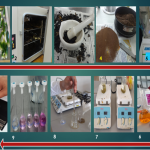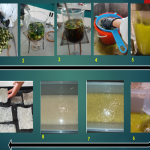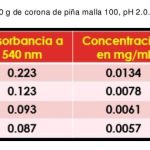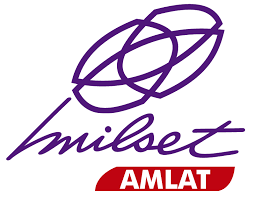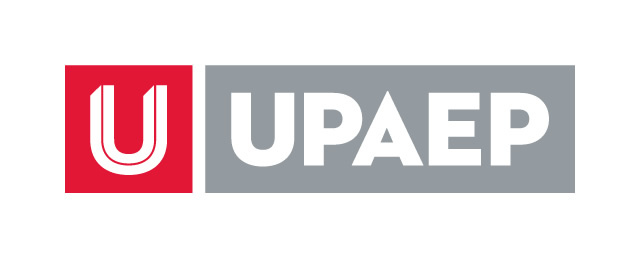NS-MA-81 USO DE LA CORONA DE PIÑA (Ananas Comosus L) PARA ADSORBER CROMO HEXAVALENTE Y ELABORACION DE PAPEL
NS-MA-81 USO DE LA CORONA DE PIÑA (Ananas Comosus L) PARA ADSORBER CROMO HEXAVALENTE Y ELABORACION DE PAPEL
Categoría: Superior (Licenciatura)
Área de participación: Medio Ambiente
Resumen
La presente investigación titulada Uso de la corona de piña (Ananas comosus L) para
absorber cromo hexavalente y elaboración de papel presenta los resultados obtenidos de
la adsorción de Cr+6 en los cuales se consideraron como variables el tamaño de partícula
de la corona de piña, el pH, cantidad de adsorbente, así como el tiempo de contacto entre
el adsorbente y el adsorbato. Se determinó que el pH de mejor adsorción fue de 2.0, el
tamaño de partícula de mejor adsorción fue de 0.149 mm (malla 100), El tiempo de mayor
adsorción fue a los 60 minutos. Se elaboró papel con hidrólisis alcalina de la corona de
piña.
Pregunta de Investigación
¿Será posible que la corona de piña pueda adsorber cromo hexavalente en solución y además será posible elaborar papel con la corona de piña?Planteamiento del Problema
La contaminación por metales pesados y metaloides en recursos hídricos, suelos y aire
plantea una de las más severas problemáticas que comprometen la seguridad alimentaria
y salud pública a nivel global y local. Un metal pesado se suele definir como un elemento
químico de propiedades metálicas con una elevada densidad, aunque también hay quien
considera que hay que referirse al número o peso atómico o a alguna de sus propiedades
químicas o de toxicidad para diferenciarlos de otros metales. Suelen denominarse así para
apelar a su impacto medioambiental, aunque éste dependa de la cantidad en que se
encuentre en los ecosistemas y de si experimentan alteraciones.
Son metales como el mercurio, el plomo o el cromo que pueden llegar a ser perjudiciales
en grandes cantidades o tras alteraciones, ya que aumentan en toxicidad y bioacumulación,
ya que se acumulan en el organismo y no se eliminan ni por las heces, ni por la orina, ni a
través del sudor. Por ejemplo, el mercurio es más tóxico en forma de metilmercurio o
dimetilmercurio, y el cromo VI es altamente peligroso mientras que el cromo III es un
nutriente esencial para los humanos.
El agua contiene metales pesados de forma natural, sin embargo, su incremento, aunque
a veces también viene determinado por un enriquecimiento natural al pasar por acuíferos
en los que hay rocas con una elevada concentración de esta materia, mayoritariamente
está vinculado a la actividad humana, como la minería y la industria, que genera residuos
como el plomo, el mercurio, el cadmio, el arsénico y el cromo, que llegan a los ríos y
contaminan las aguas subterráneas.
Por ejemplo, el mercurio, el zinc, el plomo, el cobre, el cadmio, el cromo y el níquel se usan
en la pintura de la industria textil y gráfica, y para galvanizado de metales, así como para
procesar papel en la industria papelera y como aditivo en la industria peletera, y el arsénico
también se usa como aditivo en la industria del plástico.
Estas y otras actividades, como la combustión de gasolina con plomo, también liberan
metales como el plomo a la atmósfera, que llega al agua de los ríos y a los acuíferos, y que
se usa para la agricultura y la ganadería acumulándose en el organismo de los animales y
en las plantas que ingerimos, además del agua del grifo que bebemos.
El cromo, como el cadmio, se usa en una gran cantidad de industrias, especialmente las
que usan pigmentos y las que lo usan como aditivo, como es el caso de la industria peletera
y de los plásticos. Llega al agua, por lo tanto, a través de su vertido a los ríos, además de
a través del aire por combustión y después por la lluvia.
Finalmente se debe considerar que el cromo puede causar problemas en la piel y
respiratorios, así como daños en el hígado y el sistema inmunológico, entre otros, cuando
se altera y se transforma en Cromo VI.
Este metal puede reducirse con la aplicación de procesos de prevención de la
contaminación en las industrias y su reciclado. La apuesta por energías limpias que no
dependan de la combustión de carbón también minimiza la presencia de Cromo en el aire
que pueda terminar en el agua.
Antecedentes
Con base al tema de investigación del proyecto, las diferentes consultas realizadas, se
plantea el siguiente estado del arte: A nivel internacional en base a la absorción de cromo
con la corona de piña en 2019 Ecuador- Cuenca se realizó un trabajo experimental acerca
de “Determinación de la capacidad de bio sorción y desorción de la corona de piña para la
remoción de metales pesados” Andrea Paulina Tamay Crespo como Autora y el Ingeniero
Pablo Arévalo Moscoso, Ph. D como Tutor, en donde concluyeron que la corona de piña
como bio sorbente tiene la capacidad de bio sorción y desorción de los iones metálicos
estudiados, obteniendo resultados superiores al 70% mayores a otro trabajo experimental
realizado por Cabrera Andrade (2017), Ordóñez Ochoa (2017) y Verdugo Vergara (2017).
Por otro lado, en base a la elaboración de papel en Diciembre 2016 Colombia; La revista
NOVA público un Articulo realizado por Sandra María Rozo Gálvez, Andrés Yesid González
Laguado y Jesús Antonio Villamizar Loaiza, Titulado “ELABORACIÓN DE UN PAPEL
ECOLÓGICO A BASE DE COGOLLOS DE PIÑA” plantean que el producto elaborado parte
de una materia prima (cogollos de piña) considerada como desecho agroindustrial por las
empresas que utilizan la piña como insumo, para lograr transformar este residuo en un bien
estructurado como lo es el papel. Obteniendo como resultado un papel de buena calidad,
con fibras y textura similar al papel Kimberly, que puede ser empleado para cualquier tipo
de uso doméstico o profesional, de diversos tamaños, espesores y colores.
Noviembre 2020, La página Red de Repositorios Latinoamericanos, publicaron un resumen
acerca de “Utilización de la corona de piña (Ananas comosus) para la elaboración de papel
ecológico artesanal, Chiclayo “
Dirigido por La Universidad César Vallejo en Perú; Cieza Tarrillo, Yakelin Yulisa como
Autores declaran que la hoja de papel que obtuvo un óptimo resultado en gramaje fue el
primer proceso que realizaron con un 86, 26 ¿g/m2, siendo proporcional al grosor, el
gramaje presentó 116um y las muestras de blancura, se obtuvieron en los procesos 2 y 3
en un 59, 5%. La elaboración de papel les permitió obtener 29 hojas A4 usando 5 kg para
cada proceso.
A medida que pasan los años en el campo de investigación se han buscado diversas formas
de aprovechar los residuos agroindustriales y alimentarios, debido a que si estos no se
eliminan de una manera adecuada se convierten directamente en residuos causantes de
una mayor contaminación mediante generación de CO2, Especialmente
generación de CO2. Especialmente en frutas se ha buscado aprovechar al máximo todos
sus componentes (Cascara/Piel, Corazón, Semillas y Los Extremos o Coronas) ya que es
el desperdicio que mayor se genera en casa, en los llamados mercados/tianguis e incluso
industrias productoras de alimentos. La piña es conocida como Anana comosus,
pertenecen a la familia de las bromeliácea, del género Ananás, es originaria de América del
sur. Es una planta herbácea perenne, que llega a una altura de hasta 1.2 metros en su edad
adulta, (Wesley Coulter, 1983). La piña cuenta con una piel bastante gruesa y una corona
que comúnmente se desecha sin darle ningún otro uso, dejándolo sin aprovechar la mayor
parte del volumen que genera.
Debido a esta problemática y para el aprovechamiento de la pulpa y cascara de piña Costa
Rica ha buscado una alternativa, en donde se utiliza por los productores de bovinos, estos
reportan que se han visto resultados positivos en la producción de leche (Gutiérrez, Rojas,
Dormond, Poore, & Ching Wing,2003). Un segundo uso que se ha vuelto famoso para el
aprovechamiento de los residuos de esta fruta es la obtención de bromelina, esta es una
proteína que cataliza la hidrolisis de los enlaces peptídicos de las proteínas, esta enzima
se utiliza como ablandador de carnes y es también usado como
complemento en alimentos. (Catucuago Sánchez, 2023). Uno de los estudios más
decientes sobre el aprovechamiento de los desechos de la piña, ncluidas las coronas de
piña, es la eliminación de metales pesados. El foco de este estudio es la presencia de
grandes cantidades de metales pesados en la industria y sus efluentes, que a menudo
ingresan a la industria cuando la contaminación ha alcanzado niveles de preocupación
altos. (Tamay) Crespo, 2019.
Objetivo
Objetivo General
Determinar las condiciones óptimas para la adsorción de cromo hexavalente con corona de
piña y elaborar papel.
OBJETIVOS PARTICULARES
Determinar el efecto del tamaño de partícula de la corona de piña en la adsorción de cromo
hexavalente.
Determinar el efecto del pH en la adsorción de cromo hexavalente.
Determinar el efecto de la cantidad de corona de piña en la adsorción de cromo
hexavalente.
Determinar el efecto del tiempo de contacto entre la corona de piña y la solución de cromo
hexavalente.
Justificación
Desarrollar un método de adsorción con corona de piña para eliminar cromo hexavalente
de medios acuíferos y así evitar que las personas lo consuman indirectamente de aguas
provenientes de fuente que no tienen el tratamiento adecuado para eliminarlo, así como
elaborar papel a base de corona de piña para disminuir el uso de árboles como fuente de
celulosa para fabricar papel es la plena justificación de este proyecto de investigación.
Hipótesis
Si se determinan las condiciones óptimas de adsorción de la corona de piña como tamaño
de partícula, pH, cantidad de corona de piña y tiempo de contacto entre la corona de piña
y el cromo hexavalente, entonces será posible utilizar la corona de piña como material
adsorbente de cromo hexavalente eficaz y económico.
Método (materiales y procedimiento)
A) Adsorción de cromo hexavalente
A continuación, se presenta la metodología para la adsorción de cromo hexavalente:
1. Lavado de las hojas de la corona de piña
2. Secado de las hojas al sol y después a estufa a 50° C por 24 horas
3. Molienda de las hojas secas
4. Tamizado por malla 50 y malla 100
5. Preparación de soluciones de dicromato de potasio, ácido sulfúrico y
difenilcarbazida
6. Se pesaron 0.5 g, 1.0 g, 2.0 g y 4.0 g de corona de piña molida mallas 50, 100 y sin
tamizar.
7. Se pusieron 100 ml de solución de dicromato de potasio en un vaso de precipitado
de 250 ml y las cantidades referidas en el paso anterior y se agitaron a 350 rpm
durante tiempos de 15 min, 30 min,45 min y 60 min
8. Transcurridos los tiempos se filtró y se tomaron alícuotas de 2 ml del filtrado para
desarrollar color co difenilcarbazida.
9. Se hizo lecturas de las muestras en un espectrómetro UV-VIS a 540 nm
10. Se realizó una curva de calibración de dicromato de potasio
11. Se realizaron los cálculos correspondientes.
B) Elaboración de papel
A continuación, se presenta la metodología para la elaboración de papel
1. Lavado de las hojas de la corona de piña
2. Cortar las hojas de piña con tijeras en tamaños pequeños
3. Hidrolizar las hojas recortadas de piña con hidróxido al 10 % hasta obtener un líquido
café muy obscuro (licor negro)
4. Desechar el licor negro (café muy oscuro) pasando por un colador
5. Enjuagar con abundante agua la torta retenida en el colador
6. Colocar la torta en un recipiente y adicionar hipoclorito de sodio para blanquear
(eliminar el color verde) por 24 horas.
7. Extender sobre una malla metálica cuadriculada o sobre una superficie plana la fibra
blanqueada y dejar secar a temperatura ambiente, no exponer a rayos directos del sol.
8. Despegar de la superficie lisa el papel que se ha formado.
Resultados
- a) Adsorción de cromo hexavalente
Se realizó una curva de calibración de cromo hexavalente la cual se hizo con una solución de dicromato de potasio de 2mg/ ml y se hicieron diluciones de manera que se obtuvieron concentraciones como se muestran en la tabla 1 y la curva realizada en Excel, figura 1. Se obtiene una curva con un coeficiente de correlación de 0.9977 lo cual indica que la correlación entre la absorbancia y la concentración es fuerte.
En las siguientes tablas se muestran los resultados obtenidos de la absorción de cromo hexavalente con corona de piña, considerando las variables que se indicaron en los objetivos. Para todos los cálculos se consideró la ecuación de la curva: Y = 17.863X – 00157
Donde Y es la absorbancia y X la concentración de dicromato de potasio en mg/ml.
Se puede apreciar en las tablas anteriores que a pH 2 y con malla 50, se absorbe más Cr VI, si aumentamos la cantidad de adsorbente. Cumpliéndose la regla que a mayor cantidad de adsorbente mayor cantidad de adsorbato. La mayor cantidad de Cr VI adsorbido fue con 4 g de corona de piña malla 50 y pH 2.0
Como se aprecia en la tabla 6, se absorbe muy lentamente y muy poco con malla 100 a pH 4.5 mientras que en la tabla 7 se observa que a pH 2.0 se absorbe mucho mayor cantidad de Cr VI con 2.0 g de corona de piña, lo cual indica que la acidez favorece la adsorción (ver tablas correspondientes)
En la tabla 8, se observa que con 2.0 g de corona de piña a pH 2.0, se adsorbe 10.35 % más Cr VI, correspondiendo que a mayor cantidad de adsorbente mayor adsorción del adsorbato.
b) Elaboración de papel
Siguiendo la metodología propuesta, se obtuvo papel el cual se muestra en las siguientes imágenes: (Figura 4)
Discusión
Se puede apreciar en las tablas que a pH 2 y con malla 50, se absorbe más Cr VI, si aumentamos la cantidad de adsorbente. Cumpliéndose la regla que a mayor cantidad de adsorbente mayor cantidad de adsorbato. La mayor cantidad de Cr VI adsorbido fue con 4 g de corona de piña malla 50 y pH 2.0
Como se aprecia en la tabla 6, se absorbe muy lentamente y muy poco con malla 100 a pH 4.5 mientras que en la tabla 7 se observa que a pH 2.0 se absorbe mucho mayor cantidad de Cr VI con 2.0 g de corona de piña, lo cual indica que la acidez favorece la adsorción (ver tablas correspondientes)
En la tabla 8, se observa que con 2.0 g de corona de piña a pH 2.0, se adsorbe 10.35 % más Cr VI, correspondiendo que a mayor cantidad de adsorbente mayor adsorción del adsorbato.
Conclusiones
Con base a los objetivos planteados al inicio de la investigación podemos concluir lo siguiente:
- La corona de piña, si adsorbe al cromo hexavalente hasta un 96 % a pH 2.0 y con tamaño de partícula de .149 mm (malla 100)
- Se determinó el efecto del tamaño de partícula de la corona de piña en la adsorción de cromo hexavalente, encontrándose que la malla número 100 es la que mejor adsorbe cromo VI.
- Se determinó el efecto del pH en la adsorción de cromo hexavalente, encontrándose que a pH 2 se obtienen mejores porcentajes de adsorción de cromo VI
- Se determinó el efecto de la cantidad de corona de piña en la adsorción de cromo hexavalente, encontrándose que a mayor cantidad de adsorbente mayor será la cantidad de cromo VI adsorbida.
- Se determinó el efecto del tiempo de contacto entre la corona de piña y la solución de cromo hexavalente, encontrándose que a mayor tiempo de contacto mayor cantidad de cromo VI adsorbida.
- Se logró obtener papel con la hidrólisis alcalina de la corona de piña en color verde por la clorofila y en blanco.
Bibliografía
- TAMAY CRESPO, A. P. (2019). Determinación de la capacidad de biosorción y desorción de la corona de piña para la remoción de metales pesados. Tesis. Universidad Politécnica Salesiana, sede Cuenca., Ecuador, 2019.
- Areco, María Mar. (2020) Biosorción, una técnica sustentable para la remoción de metales pesados de efluentes contaminados. Las Fronteras de la Física y Química Ambiental en Ibero América. 123-127
- Alvarez Hijosa, C. (2014). Piñatex, the Design Development of a New Sustainable Material. Royal College of Art.
- Schiewer, S.; Volesky, B., 1995. Modelling of the proton–metal ion exchange in biosorption. Environ. Sci. Technol. 29, 3049–3058
- Harry, E., 1999. Treatment of metal-contaminated wastes: why select a biological process. Trends Biotechnol. 17 (12), 462–465.
- Harry, E., 1999. Treatment of metal-contaminated wastes: why select a biological process. Trends Biotechnol. 17 (12), 462–465. 3) Volesky, B., 1990. Biosorption of heavy metals. CRC Press, Boca Raton, FL.
- Esteves, A.J.P.; Valdman E.; Leite, S.G.F., 2000. Repeated removal of cadmium and zinc from an industrial effluent by waste biomass Sargassum sp. Biotechnology Letters, 22(6), 499-502.
- Ariff, A.B., Mel, M., Hasan, M.A., Karim, M.I.A., 1999. The kinetics and mechanism of lead (II)
Biosorption by powderized Rhizopus oligosporus. World J. Microbiol. Biotechnol. 15, 291–298
NS-MA-81 USO DE LA CORONA DE PIÑA (Ananas Comosus L) PARA ADSORBER CROMO HEXAVALENTE Y ELABORACION DE PAPEL
NS-MA-81 USO DE LA CORONA DE PIÑA (Ananas Comosus L) PARA ADSORBER CROMO HEXAVALENTE Y ELABORACION DE PAPEL
Summary
The present research entitled Use of pineapple crown (Ananas comosus L) for
absorbing hexavalent chromium and papermaking presents the results obtained from
the adsorption of Cr+6 in which the particle size were considered as variables
of the pineapple crown, the pH, amount of adsorbent, as well as the contact time between
the adsorbent and the adsorbate. It was determined that the best adsorption pH was 2.0, the
the best adsorption particle size was 0.149 mm (100 mesh), the longest
adsorption was at 60 minutes. Paper was made with alkaline hydrolysis of the crown of
pineapple.
Research Question
Will it be possible that the pineapple crown can adsorb hexavalent chromium in solution and will it also be possible to make paper with the pineapple crown?Problem approach
Heavy metal and metalloid pollution in water resources, soil and air
it poses one of the most serious problems that compromise food security
and public health at the global and local level. A heavy metal is usually defined as an element
chemical of metallic properties with a high density, although there are also those who
consider that it is necessary to refer to the atomic number or weight or some of its properties
chemical or toxicity to differentiate them from other metals. They are usually called that for
appeal to its environmental impact, even if this depends on the amount in which
find in the ecosystems and of whether they experience alterations.
They are metals such as mercury, lead or chromium that can become harmful
in large quantities or after alterations, as they increase in toxicity and bioaccumulation,
since they accumulate in the body and are not eliminated either by feces, urine, or
through the sweat. For example, mercury is most toxic in the form of methylmercury or
dimethylmercury, and chromium VI is highly dangerous while chromium III is a
an essential nutrient for humans.
Water naturally contains heavy metals, however, their increase, although
sometimes it is also determined by a natural enrichment when passing through aquifers
in which there are rocks with a high concentration of this matter, mostly
it is linked to human activity, such as mining and industry, which generates waste
such as lead, mercury, cadmium, arsenic and chromium, which reach the rivers and
they pollute groundwater.
For example, mercury, zinc, lead, copper, cadmium, chromium and nickel are used
in the painting of the textile and graphic industry, and for galvanizing of metals, as well as for
process paper in the paper industry and as an additive in the fur industry, and arsenic
it is also used as an additive in the plastics industry.
These and other activities, such as the combustion of leaded gasoline, also release
metals such as lead to the atmosphere, which reaches the water of rivers and aquifers, and that
it is used for agriculture and animal husbandry accumulating in the organism of animals and
in the plants we ingest, in addition to the tap water we drink.
Chromium, like cadmium, is used in a large number of industries, especially the
that use pigments and those that use it as an additive, as is the case of the fur industry
and of plastics. It reaches the water, therefore, through its discharge into the rivers, in addition to
through the air by combustion and then by rain.
Finally it should be considered that chromium can cause skin problems and
respiratory, as well as liver and immune system damage, among others, when
it is altered and transformed into Chromium VI.
This metal can be reduced with the application of prevention processes of the
pollution in industries and their recycling. The commitment to clean energy that does not
depend on the combustion of coal also minimizes the presence of Chromium in the air
that may end up in the water.
Background
Based on the research topic of the project, the different consultations carried out, will
raises the following state of the art: Internationally based on the absorption of chromium
with the pineapple crown in 2019 Ecuador- Cuenca an experimental work was carried out about
of “Determination of the bio-sorption and desorption capacity of the pineapple crown for the
removal of heavy metals” Andrea Paulina Tamay Crespo as Author and Engineer
Pablo Arévalo Moscoso, Ph.D. D as a Tutor, where they concluded that the pineapple crown
as a bio sorbent it has the ability of bio sorption and desorption of metal ions
studied, obtaining results greater than 70% higher than other experimental work
made by Cabrera Andrade (2017), Ordóñez Ochoa (2017) and Verdugo Vergara (2017).
On the other hand, based on the preparation of paper in December 2016 Colombia; The magazine
NOVA public an Article by Sandra María Rozo Gálvez, Andrés Yesid González
Laguado and Jesús Antonio Villamizar Loaiza, Entitled “ELABORATION OF A PAPER
ORGANIC BASED ON PINEAPPLE BUDS” suggest that the product made part
of a raw material (pineapple buds) considered as agroindustrial waste by the
companies that use pineapple as an input, in order to transform this waste into a good
structured as the paper is. Obtaining as a result a good quality paper,
with fibers and texture similar to Kimberly paper, which can be used for any type
for domestic or professional use, of various sizes, thicknesses and colors.
November 2020, The Latin American Repositories Network page, published a summary
about “Use of pineapple crown (Ananas comosus) for paper making
ecological artisanal, Chiclayo “
Directed by the César Vallejo University in Peru; Cieza Tarrillo, Yakelin Yulisa as
Authors declare that the sheet of paper that obtained an optimal result in grammage was the
first process they performed with an 86, 26¿g/m2, being proportional to the thickness, the
grammage presented 116um and the whiteness samples, were obtained in processes 2 and 3
by 59.5%. Papermaking allowed them to obtain 29 A4 sheets using 5 kg for
every process.
As the years have passed in the field of research, various ways have been sought
to take advantage of agroindustrial and food waste, because if these are not
disposed of in an appropriate way are directly converted into waste causing
increased pollution through the generation of CO2, especially
generation of CO2. Especially in fruits has sought to make the most of all
its components (shell/skin, Heart, Seeds and The Ends or Crowns) as it is
the most waste is generated at home, in the so-called markets/tianguis and even
food-producing industries. The pineapple is known as Anana comosus,
they belong to the bromeliad family, of the pineapple genus, it is native to America from the
south. It is a perennial herbaceous plant, which reaches a height of up to 1.2 meters in its age
adult, (Wesley Coulter, 1983). The pineapple has a fairly thick skin and a crown
that is commonly discarded without giving it any other use, leaving it without taking advantage of the greater
part of the volume it generates.
Due to this problem and for the use of the pulp and shell of pineapple Costa
Rica has sought an alternative, where it is used by cattle producers, these
report that positive results have been seen in milk production (Gutierrez, Rojas,
Dormond, Poore, & Ching Wing, 2003). A second use that has become famous for the
utilization of the residues of this fruit is the obtaining of bromelain, this is a
a protein that catalyzes the hydrolysis of peptide bonds in proteins. this enzyme
it is used as a meat tenderizer and is also used as
complement in food. (Catucuago Sánchez, 2023). One of the most
decisions on the use of pineapple waste, including the crowns of
pineapple, is the removal of heavy metals. The focus of this study is the presence of
large quantities of heavy metals in industry and their effluents, which often
they enter the industry when pollution has reached levels of concern
stops. (Tamay) Crespo, 2019.
Objective
OVERALL OBJECTIVES
To determine the optimal conditions for the adsorption of hexavalent chromium with corona de
pineapple and make paper.
PARTICULAR OBJECTIVES
To determine the effect of pineapple crown particle size on chromium adsorption
hexavalent.
To determine the effect of pH on the adsorption of hexavalent chromium.
To determine the effect of the amount of pineapple crown on chromium adsorption
hexavalent.
To determine the effect of the contact time between the pineapple crown and the chromium solution
hexavalent.
Justification
To develop a pineapple crown adsorption method to remove hexavalent chromium
of aquifer media and thus prevent people from consuming it indirectly from water
from sources that do not have the proper treatment to eliminate it, as well as
to make paper based on pineapple crown to reduce the use of trees as a source of
cellulose to make paper is the full justification of this research project.
Hypothesis
If the optimal conditions of adsorption of the pineapple crown are determined as size
of particle, pH, amount of pineapple crown and contact time between the pineapple crown
and hexavalent chromium, then it will be possible to use the pineapple crown as a material
effective and economical hexavalent chromium adsorbent.
Method (materials and procedure)
A) Adsorption of hexavalent chromium
The methodology for the adsorption of hexavalent chromium is presented below:
1. Washing the leaves of the pineapple crown
2. Drying the leaves in the sun and then on a stove at 50°C for 24 hours
3. Grinding of dried leaves
4. Sieving by 50 mesh and 100 mesh
5. Preparation of solutions of potassium dichromate, sulfuric acid and
diphenylcarbazide
6. 0.5 g, 1.0 g, 2.0 g and 4.0 g of crown of ground pineapple were weighed meshes 50, 100 and without
sift.
7. 100 ml of potassium dichromate solution was put in a beaker
of 250 ml and the amounts referred to in the previous step and were stirred at 350 rpm
during times of 15 min, 30 min, 45 min and 60 min
8. After the elapsed times it was filtered and 2 ml aliquots of the filtrate were taken to
develop color co diphenylcarbazide.
9. Readings of the samples were made on a UV-VIS spectrometer at 540 nm
10. A calibration curve of potassium dichromate was performed
11. The corresponding calculations were performed.
(B) Making of paper
The following is the methodology for the preparation of paper
1. Washing the leaves of the pineapple crown
2. Cut the pineapple leaves with scissors into small sizes
3. Hydrolyze the trimmed pineapple leaves with 10% hydroxide until a liquid is obtained
very dark coffee (black liquor)
4. Discard the black liquor (very dark coffee) through a sieve
5. Rinse the cake retained in the colander with plenty of water
6. Place the cake in a bowl and add sodium hypochlorite to whiten
(remove the green color) for 24 hours.
7. Spread on a grid metal mesh or on a flat surface the fiber
bleached and let dry at room temperature, do not expose to direct sun rays.
8. Peel off the paper that has been formed from the smooth surface.
Results
a) Adsorption of hexavalent chromium
A hexavalent chromium calibration curve was made which was made with a potassium dichromate solution of 2 mg/ml and dilutions were made so that concentrations were obtained as shown in Table 1 and the curve made in Excel, Figure 1 . A curve with a correlation coefficient of 0.9977 is obtained which indicates that the correlation between absorbance and concentration is strong.
The following tables show the results obtained from the absorption of hexavalent chromium with pineapple crown, considering the variables indicated in the objectives. For all calculations the equation of the curve was considered: Y = 17.863X – 00157
Where Y is the absorbance and X is the concentration of potassium dichromate in mg/ml.
It can be seen from the above tables that at pH 2 and with 50 mesh, more Cr VI is absorbed, if we increase the amount of adsorbent. Fulfilling the rule that the greater the amount of adsorbent, the greater the amount of adsorbate. The highest amount of Cr VI adsorbed was with 4 g of pineapple crown 50 mesh and pH 2.0
As can be seen in Table 6, it is absorbed very slowly and very little with 100 mesh at pH 4.5 while in Table 7 it is observed that at pH 2.0 a much greater amount of Cr VI is absorbed with 2.0 g of pineapple crown, which indicates that the acidity favors the adsorption (see corresponding tables)
In Table 8, it is observed that with 2.0 g of pineapple crown at pH 2.0, 10.35% more Cr VI is adsorbed, the greater the amount of adsorbent, the greater the adsorption of the adsorbate.
(b) Making of paper
Following the proposed methodology, paper was obtained which is shown in the following images: (Figure 4)
Discussion
It can be seen in the tables that at pH 2 and with 50 mesh, more Cr VI is absorbed, if we increase the amount of adsorbent. Fulfilling the rule that the greater the amount of adsorbent, the greater the amount of adsorbate. The highest amount of Cr VI adsorbed was with 4 g of pineapple crown 50 mesh and pH 2.0
As can be seen in Table 6, it is absorbed very slowly and very little with 100 mesh at pH 4.5 while in Table 7 it is observed that at pH 2.0 a much greater amount of Cr VI is absorbed with 2.0 g of pineapple crown, which indicates that the acidity favors the adsorption (see corresponding tables)
In Table 8, it is observed that with 2.0 g of pineapple crown at pH 2.0, 10.35% more Cr VI is adsorbed, the greater the amount of adsorbent, the greater the adsorption of the adsorbate.
Conclusions
Based on the objectives set at the beginning of the research we can conclude the following:
The pineapple crown, if adsorbs to hexavalent chromium up to 96% at pH 2.0 and with particle size of.149 mm (100 mesh)
The effect of the pineapple crown particle size on the hexavalent chromium adsorption was determined, finding that the 100 mesh is the one that best adsorbs chromium VI.
The effect of pH on the adsorption of hexavalent chromium was determined, finding that at pH 2 better percentages of chromium VI adsorption are obtained
The effect of the amount of pineapple crown on the adsorption of hexavalent chromium was determined, finding that the greater the amount of adsorbent, the greater the amount of chromium VI adsorbed.
The effect of the contact time between the pineapple crown and the hexavalent chromium solution was determined, finding that the longer the contact time, the greater the amount of chromium VI adsorbed.
It was possible to obtain paper with the alkaline hydrolysis of the pineapple crown in green color by chlorophyll and in white.
Bibliography
TAMAY CRESPO, A.P. (2019). Determination of the biosorption and desorption capacity of the pineapple crown for the removal of heavy metals. Thesis. Salesian Polytechnic University, Cuenca headquarters., Ecuador, 2019.
Areco, María Mar. (2020) Biosorption, a sustainable technique for the removal of heavy metals from contaminated effluents. The Frontiers of Environmental Physics and Chemistry in Ibero-America. 123-127
Alvarez Hijosa, C. (2014). Piñatex, the Design Development of a New Sustainable Material. Royal College of Art.
Schiewer, S.; Volesky, B., 1995. Modelling of the proton-metal ion exchange in biosorption. Environ. Sci. Technol. 29, 3049–3058
Harry, E., 1999. Treatment of metal-contaminated wastes: why select a biological process. Trends Biotechnol. 17 (12), 462–465.
Harry, E., 1999. Treatment of metal-contaminated wastes: why select a biological process. Trends Biotechnol. 17 (12), 462–465. 3) Volesky, B., 1990. Biosorption of heavy metals. CRC Press, Boca Raton, FL.
Esteves, A.J.P.; Valdman E.; Leite, S.G.F., 2000. Repeated removal of cadmium and zinc from an industrial effluent by waste biomass Sargassum sp. Biotechnology Letters, 22(6), 499-502.
Ariff, A.B., Mel, M., Hasan, M.A., Karim, M.I.A., 1999. The kinetics and mechanism of lead (II)
Biosorption by powderized Rhizopus oligosporus. World J. Microbiol. Biotechnol. 15, 291–298


